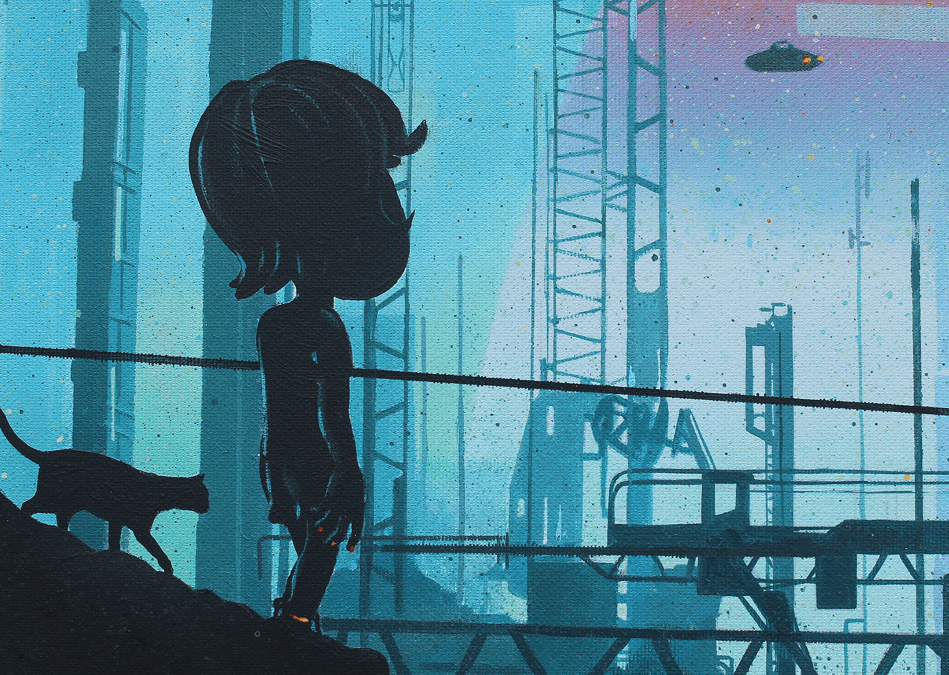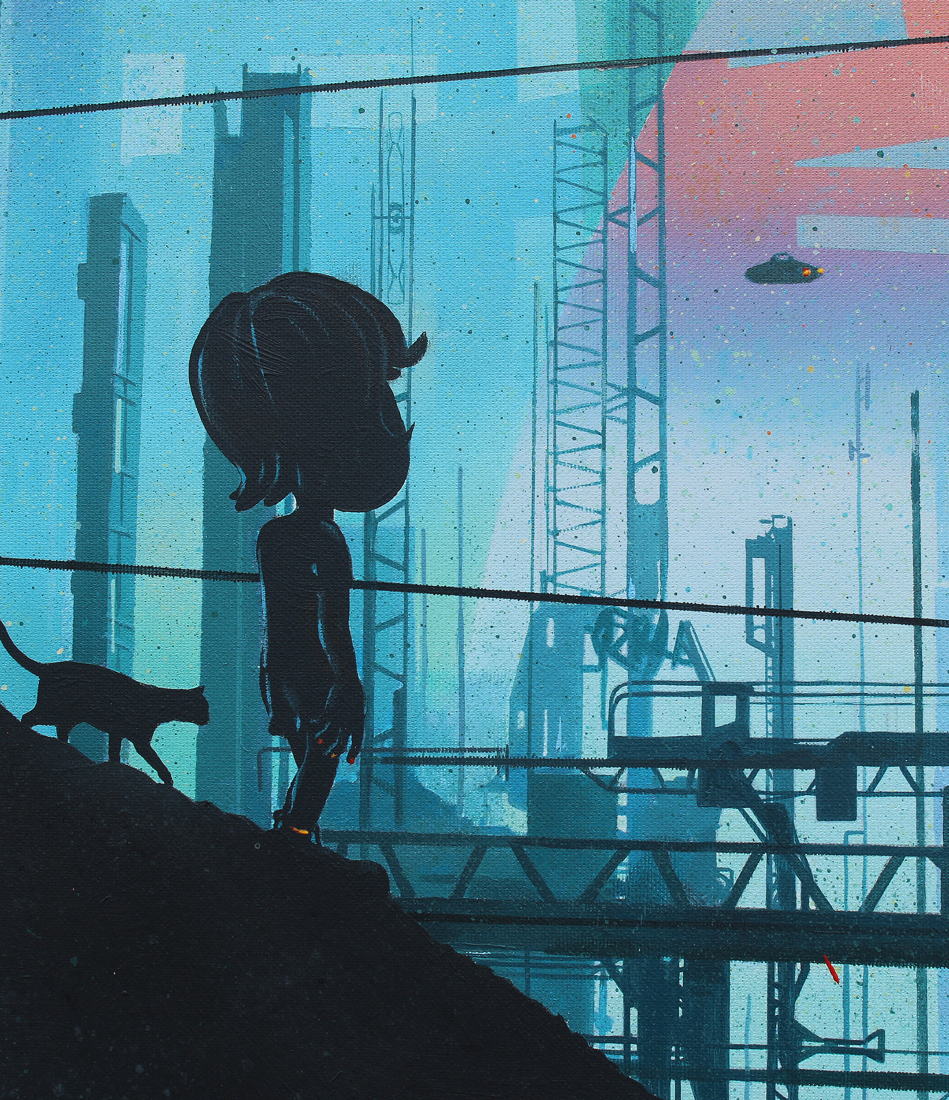SuperRare Labs Senior Curator An interviews ALIENQUEEN about psychedelics, death, and her journey in the NFT space.

The chant of solitude: Dangiuz meets Giovanni Motta
What a Dream Looks Like? is the result of the collaboration between the artists Dangiuz (Leopoldo D’Angelo) and Giovanni Motta, which consists of the encounter between two parallel but coherent visual universes. Dangiuz developed the digital work, the NFT in which he inserted the character of Jonny Boy created by Giovanni Motta in his classic cyberpunk urban scenarios to represent the inner child in all of us. Giovanni Motta transferred Dangiuz’s digital work into painting, creating an acrylic on canvas in a 100×80 cm format.
What a Dream Looks Like? is a work of expanded reality in which material and immaterial meet in the perfect combination of two thoughts and two modes of operation.
Whoever buys the NFT also gets the painting, thus obtaining both works, the expression of a single shared creation.
By Ivan Quaroni,
Art critic and curator

“What Dreams Look Like?”, Digital artwork 2021
But the dreams came on in the Japanese night like livewire voodoo, and he’d cry for it, cry in his sleep, and wake alone in the dark, curled in his capsule…
— WILLIAM GIBSON, NEUROMANCER
It is not the collision of two worlds, the forced admittance of two different infospheres, but rather a temporal intersection, the momentary confluence of two parallel visions which tell the same story from two different points of view.
What characterizes the collaboration between Dangiuz (Torino, 1995) and Giovanni Motta (Verona, 1971) is also the possibility for two generations, Z and X, to talk through the binary code of the machine and the technological language of painting. They both build their vision in the digital environment, but they want to translate their images built of bits into the particulate and atomic reality of the object. Motta offers Dangiuz the possibility to transform the digital alchemy of his projections into the evanescent materiality of painting. In exchange, he asks him to host Jonny Boy, his pictographic avatar, inside his melancholic cyberpunk universe. It seems to be a fair exchange, the exploration of a potentiality in which real and virtual eventually expand each other mutually.
The common meeting ground is the decade of the Eighties, the decade which obsesses the subcultures of the web of the new millennium with a pervasive multiplication of aesthetic and musical genres, from Vaporwave to Outrun, from Synthwave to Dreamwave, passing through subgenres such as Horror Synth and Dark Synth, mediated by cinematografic and recreational- video reminiscences which linger, like electrical phantoms, in the neural circuits of the web surfers. Giovanni Motta lived the Eighties, he has metabolized them, recalled them and then examined them through the practise of regressive meditation; Dangiuz, instead, has dreamt about them, he has re-imagined and filtered them through the synthetic landscapes of GTA Vice City and the cyberpunk dystopias of Blade Runner and Ghost in The Shell.

“What Dreams Look Like?”, painting, acrylic on canvas, 2021
The interchange occurs through the fusion of two psychogeographies: Motta’s one, inhabited by the several incarnations of the inner child, the eternal infant, source of every vital enthusiasm, and Dangiuz’s one, which assumes the configuration of a nocturnal urban mishmash, enlightened by holograms and incandescent volleys of neon lights, hence the scenery of a more than plausible near future.
In What a Dream Looks Like?, Jonny Boy is torn away from his recreational fantasies (and video- recreational ones) and from his innocent sexual impulses and he is catapulted into the harsh reality of the melting pot, the one that William Gibson preconized in Count Zero (1986), the Sprawl, a gigantic megalopolis which expands from Boston to Atlanta, or rather, the Neo-Tokyo imagined by Katsuhiro Otomo in Akira (1988), a vertical nightmare of skyways and skyscrapers linked by hanging bridges, overlooking a bottomless jungle of street levels.
It is, indeed, in the visionary territory of the retro-futuristic projections of Rick Dekard’s Los Angeles, a direct filiation of Fritz Lang’s Metropolis, that two boundless solitudes meet. On one side, Dangiuz’s romantic characters, dark silhouettes standing out from the urban metastasis which incarnates, summarizing them, all the imbalances of the final phase of late-capitalism: from the ferocious inequalities of a hyper-hierarchicalized world to the huge ecological catastrophe, from the pulverization of the social pact to the definitive political substitution of the nations control with the excessive power of the multinational corporations, from the pervasive and post-human connectivity of the servo-mechanisms and of the algorithms of the Web to the definitive and cloistered solitude of the individuals isolated in their own housing cells. On the other side, Giovanni Motta’s solipsistic geography, which transmutes childhood into a dream dilated beyond its organic limits and entrusts to Jonny Boy’s astral body the task of becoming the messenger of a hyperbolic youth, energizing and contagious device of an enthusiasm protracted ad libitum which ends up, however, becoming, in the dimension of adult life, a sort of psychic substitute of the illusory promises of cosmetic surgery. The source of eternal youth in a world that falls apart, pulverized by the chaotic and destructive processes of the Anthropocene.




“What Dreams Look Like?”
Painting – Details, Acrylic on canvas – 2021
While in Dangiuz’s cyberpunk universe the individuals face the monstrous and fascinating architectonic immensity of a dying civilization, just like the Wanderer above the Sea of Fog
by Caspar David Friedrich overlooked, in the Romantic Age, the immense force of nature, in Giovanni Motta’s aesthetic and post-manga nostalgia, human beings have to deal with their childish selves, in the attempt of rebuilding an adult identity worn out and weakened by the lattice of duties and obligations of that same dying society. They are two exorcisms which correspond with each other: the headlong rush towards a future impossible to avoid, the inner escape, towards a microcosm which opposes the inevitable senescence of the cerebral circuits.
The bicephalous work of Dangiuz and Giovanni Motta is the visual translation of a plethora of doubts and questions whose solution would require pages and pages of philosophical, scientific and sociological treaties, the aesthetic condensation of all the dilemmas of a future which no longer appears rosy. But it is also, inevitably, the photograph of a hyperstitional trajectory which can be deviated from its own unavoidable course and commuted into a potentiality already part of the present, thus, feasible.
Maybe there is a way out.



“The possibility is still there”, Franco “Bifo” Berardi writes in Futurabilità (Nero ed., Roma, 2018), “hidden in the connection among brains currently forced to operate only for the profit of the
big corporations, but potentially capable of inventing another model based on social benefit, building a social and technical platform which aims at the autonomy of the general intellect:
this is a long term program which can produce some effects.” The collaboration between two artists is the first step of this program, the aesthetic and cognitive alliance intended as a primitive utopian and revolutionary nucleus. Friendship as the reconstructive and healing cell of a pulverized sociality.
What does a dream look like? Maybe like an industrial conglomerate, a hypertrophic megalopolis cut through by the windy spiral of viaducts and rectilinear motorways. Maybe like the image of a child and a cat crossing the ruins of endless suburbs. Maybe, if we believe hard enough, it looks like a wrecked world, all to be rebuilt, a world still covered in rubble and junk, but in which we finally do not feel alone anymore.
English translation by Laura Rossi
Tech


Out of the Vault and onto the Chain: the Evolving Nature of Provenance
SuperRare editor Oli Scialdone considers the social experience of provenance and its relationship with community in the Web3 space.
Curators' Choice



Curated Conversations: ALIENQUEEN
SuperRare Labs Senior Curator An interviews ALIENQUEEN about psychedelics, death, and her journey in the NFT space.



